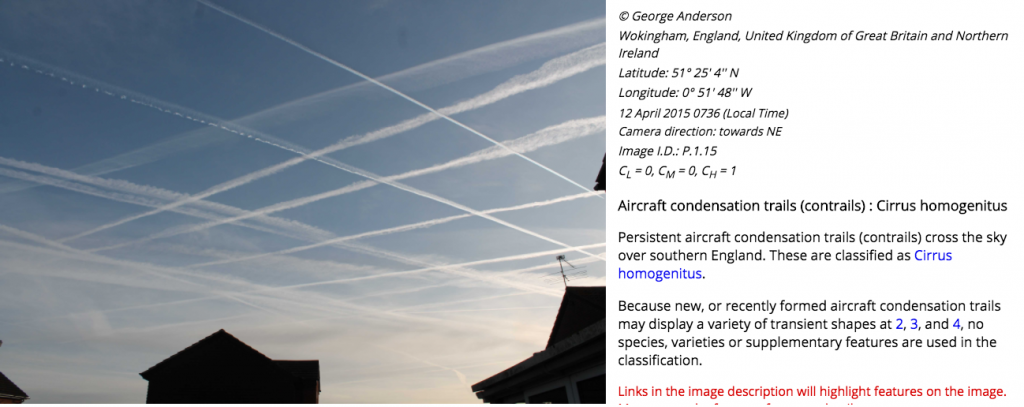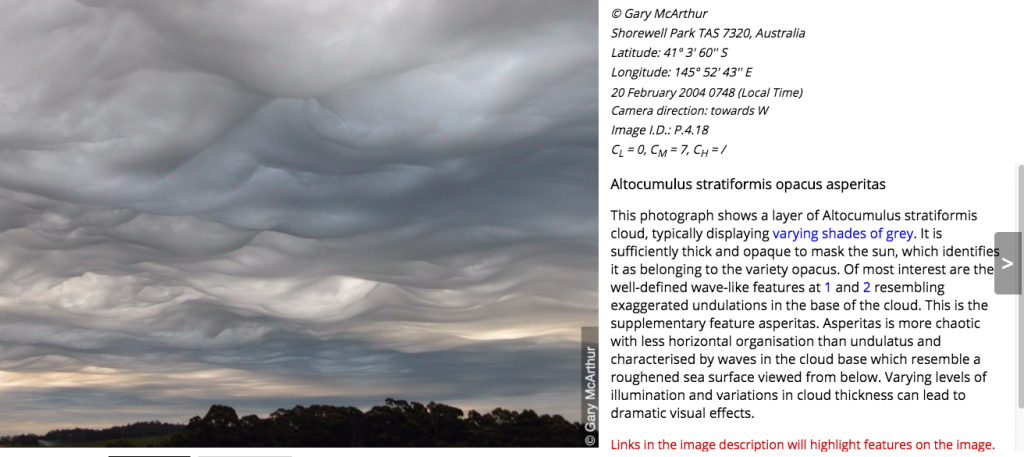25 March 2017
Look Up and Say Hello to Altocumulus Asperitus and Cirrus Homogenitus
Posted by Dan Satterfield
It was Luke Howard, a Fellow of the Royal Society, who first gave us the cloud names like cirrus, stratus, and cumulus (that we still use today), and that was way back in 1802! This is important because to understand something, you first have to observe and classify it, and this is true of all science, not just meteorology. So, it’s big news when we add some new cloud names, and if you are wondering just who gets to do that, the answer is the WMO (World Meteorological Organization). The WMO produces the International Cloud Atlas (ICA), and while you may have never heard of it, it’s the definitive guide to what constitutes an officially recognised cloud types. And, they just added one of my favourites: Asperitus.
 They also added a new type named Cirrus Homogenitus; meaning a cirrus cloud that is man generated, or in other words a jet contrail. Somehow I suspect this is will drive the chemtrail conspiracy folks to new heights of crazy. Actually, quite a lot of research now indicates these jet contrail cirrus last for hours, spread out, and become unidentifiable as once being a jet contrail. Nonetheless, they are still just frozen water crystals, and not “gub-mint mind control chemicals”, but hey, never let the facts stand in the way of a great conspiracy theory!
They also added a new type named Cirrus Homogenitus; meaning a cirrus cloud that is man generated, or in other words a jet contrail. Somehow I suspect this is will drive the chemtrail conspiracy folks to new heights of crazy. Actually, quite a lot of research now indicates these jet contrail cirrus last for hours, spread out, and become unidentifiable as once being a jet contrail. Nonetheless, they are still just frozen water crystals, and not “gub-mint mind control chemicals”, but hey, never let the facts stand in the way of a great conspiracy theory!
You can learn a lot by looking over the ICA, and the new addition is all online. It has detailed information about clouds and how they form, with satellite images, and even soundings. Asperitus, for instance, tend to form north of warm fronts (It was raining steadily soon after the image I shot at the top of this post as a warm front approached Tulsa). These asperitus clouds are very dramatic and they make a sky that is quite unforgettable. I’ve seen them only twice, and I just missed a display here in Maryland three years ago, although several viewers sent me some amazing pictures of them from Assateague Seashore. Adding a new cloud type is a rare event and a lot of folks have been rooting for asperitus, especially Gavin Pretor-Pinney of the Cloud Appreciation Society, so I am glad the push to have them made official has finally succeeded!
This would be a good time to mention that you might want to look into becoming a member of the Cloud Appreciation Society. You will not truly be a science geek unless you join, and you know that deep in your heart, don’t you.




 Dan Satterfield has worked as an on air meteorologist for 32 years in Oklahoma, Florida and Alabama. Forecasting weather is Dan's job, but all of Earth Science is his passion. This journal is where Dan writes about things he has too little time for on air. Dan blogs about peer-reviewed Earth science for Junior High level audiences and up.
Dan Satterfield has worked as an on air meteorologist for 32 years in Oklahoma, Florida and Alabama. Forecasting weather is Dan's job, but all of Earth Science is his passion. This journal is where Dan writes about things he has too little time for on air. Dan blogs about peer-reviewed Earth science for Junior High level audiences and up.
Hi,
Why haven’t connections to global warming and human made clouds had a bigger impact for change in air travel. At this time they estimate about 3.4 % of global warming in the
USA is due to these clouds, globally I would think much more. This is not a small percent and perhaps one of the things to help draw back climbing temperatures. If altitude has to do with these formations, perhaps changing the altitude planes fly at. If fuel is a contributor, perhaps looking at alternatives that do not use these ingredients. Sounds crazy but perhaps doable if we tried. Not wearing my tin foil hat but somewhat conspiratorially if no one is talking about low lying fruit and also in this case what many have been talking about for decades.
There is some cloud impact for sure already on global temps. but it is not much. Outside western Europe and the USA there are not that many contrails floating about. The bigger impact is on the co2 from the flights. This keeps adding up.